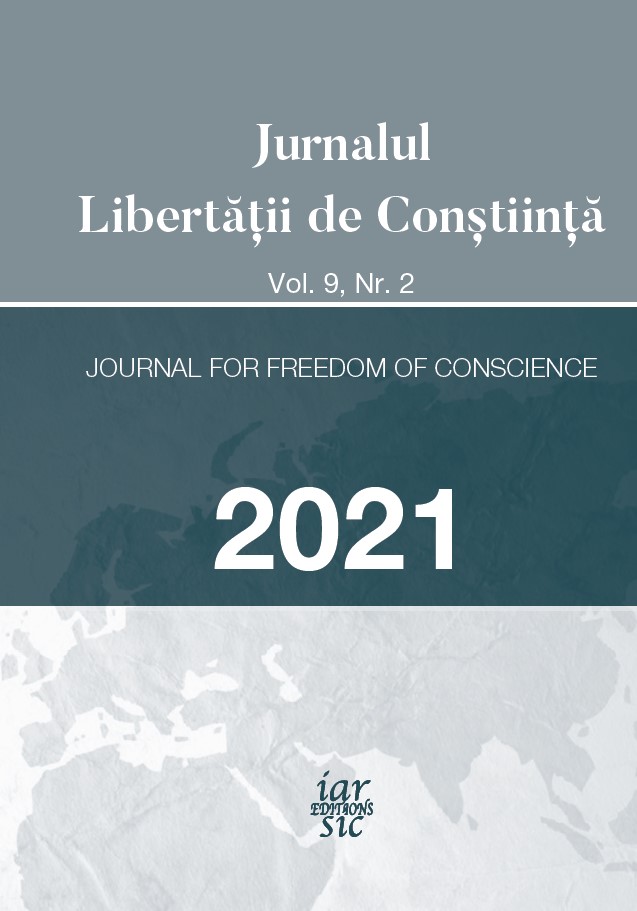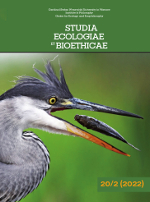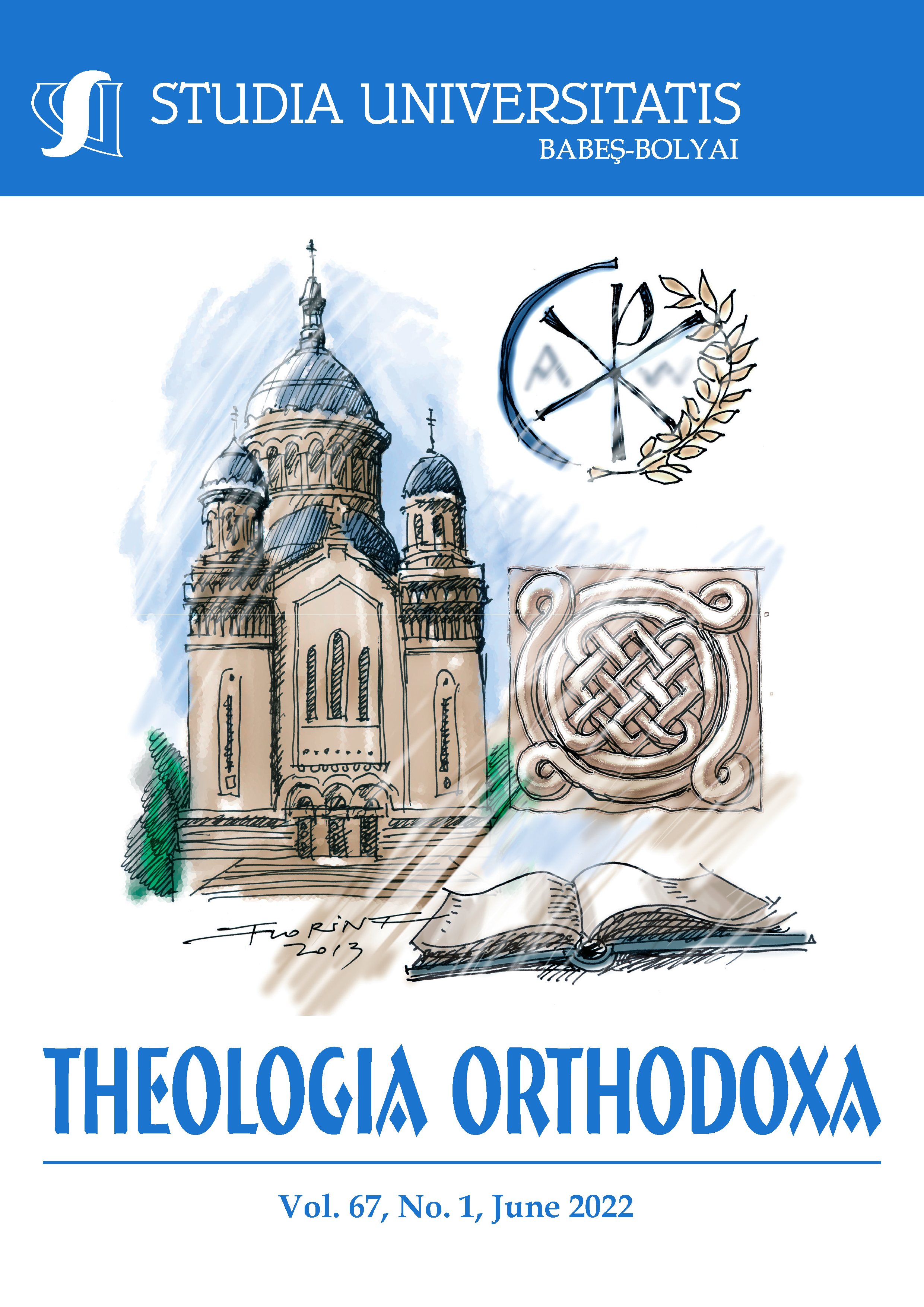
We kindly inform you that, as long as the subject affiliation of our 300.000+ articles is in progress, you might get unsufficient or no results on your third level or second level search. In this case, please broaden your search criteria.

The present paper deals with historical origins of the cross as tortureinstrument during Antiquity, starting form the Persian Empire until HellenisticEpoch. A special emphasize is put on the description of the ways in whichcrucifixion occurs in IthB.C and Ith A.C, the additional torture modalities, theplaces dedicated, as well as on the emotional impact to the audience Far apartthe particular historical aspects and the analysis of how crucifixion penetrated inthe area where Christ lived, His crucifixion is seen in the political context of theperiod, by taking into account the role of the political personalities implied andthe essential anamnetic role for that particular event.
More...

This article investigates the relationship between sin and its retribution as depicted in three Middle English biblical plays concerned with retribution, Noah’s Flood, the Harrowing of Hell and the Last Judgement, in the Chester biblical drama collection. The plays’ general tenor is, to modern sensibilities, conservative and disciplinarian with respect to social mores. Yet, studying the portrayal of sin against the plays’ social background may uncover secular mutations of the Christian conceptualisation of sin as a function of gender as well as estate. Chester’s Last Judgement dramatises sin in accordance with fifteenth-century ecclesiastical and secular developments which criminalise people along gender-specific, not just trade-specific, lines. In showing Mulier as the only human being whom Christ leaves behind in hell after his redemptive descensus, the Harrowing dooms not just the brewers’ and alehouse-keepers’ dishonesty, as imputed to brewsters in late medieval England, but women themselves, if under the guise of their trade-related dishonesty. The underside of the Chester Noahs’ cleansing voyage is women’s ideological and social suppression. Whether or not we regard the Good Gossips’ wine-drinking – for fear of the surging waters – or Mrs Noah’s defiant resistance to her husband as a performance of the sin of humankind calling for the punitive deluge, the script gives female characters a voice not only to show their sinfulness. Rather, like the Harrowing of Hell and less so the Last Judgement, Noah’s Flood, I argue, participates in a hegemonic game which appropriates one sin of the tongue, gossip, to make it backfire against those incriminated for using it in the first place: women.
More...

Book review: Andrzej Tulej, "Why are you fearful, of little faith?" Gospel stories about the storm on the lake (Mark 4:35-41; Matthew 8:23-27; Luke 8:22-25), Tyniec Benedictine Publishing House, Kraków 2021, pp. 167
More...
The synoptic gospels present the Apostle John, during the three years of discipleship next to Jesus Christ, in a different way than the Gospel of John. Along with his older brother, James, and the Apostle Peter, he is part of the small, intimate group, which is present at all the important events of the Saviour’s ministry. Jesus chooses to change John into a disciple of “love,” of gentleness, of compassion by accepting him, by unconditional love, and by entrusting him as the son of Mary, the Mother of God. The paradigm of life is shaped in his new relationship, a fact proved by the writing of the fourth Gospel: he does not mention his name, he describes himself as the disciple “whom Jesus loved”, the emphasis on love is twice as great as that of truth and justice.
More...
This study examines the notion of “conqueror” as found in Revelation 2-3, specifically at the end of the seven letters addressed by the Saviour of the churches of Asia Minor. An exegetical investigation was carried out, following the immediate context in which the term is used, but also the general message of the letter. A central place is occupied by the promises made to the victor and which give us a broad perspective on the relationship that Christ has with His Church. These promises are an integral part of the body of each letter, an indispensable and motivating rhetorical element.
More...
The Johannine Apocalypse makes it clear that the final stage of the conflict between good and evil revolves around the issue of worship, and this relates intrinsically to the Sabbath. This article pinpoints the role of the Sabbath at the close of earth’s history. Moreover, it also emphasizes the expressions and motifs of rest which are used to describe life beyond the second coming of Jesus. The concept of rest in eschatology will be discovered under three dimensions. First, rest is existential, that is in relation to the experience of salvation in Christ. Second, rest is ingrained in the worship on the Sabbath since the latter is symbolic of ceasing and comfort. Third, there is also an eternal dimension of rest, which basically stands in contrast with all the hardships the people of God undergo during the last tribulation before the eschaton.
More...
The Pauline pericope of Romans 13: 1-7, which regulates the relationship between civil and religious authority, has provoked various debates in the world of researchers as to its authenticity. Some Bible scholars (Walke, Barnikoll etc.) pass this biblical text as a pseudoepigraph. Their arguments are sorted according to ideational, contextual, linguistic, comparative and situational reasons. Following the intensification of their research based on these criteria, they came to the conclusion that the text is foreign to St. Paul’s vision and, therefore, he is not the author. In our research we have inventoried the patristic perspective related to the subject and made other new contributions to the text of the Epistle to Romans 13: 1-7, summarizing them in the form of an excursus - according to which we argue with probity that the author of this pericope is St. Apostle Paul.
More...
A predominantly philological reading of the New Testament reveals to the reader a network of unique meanings of the vocabulary of the Gospels. The article examines New Testament terms filled with many meanings, highlighted from a linguistic perspective. A dictionary of figurative meanings of fundamental New Testament terms would be of great use for the Christian education of young people.
More...
The scenario of the assault on some strongholds, used in 2 Corinthians 10:1-11, attracted the attention and admiration of the readers of this Pauline Epistle, as it imprints a fast pace as well as a certain gravity to the whole section. By its means, the Apostle Paul announces a decisive intervention on his part in the community of Corinth where a series of tensions have arisen. However, the reader immediately remarks that the vocabulary used by the author is a metaphorical one. That is why it is all the more interesting to see what Paul wanted to express by its means. Therefore, taking into account the way in which the philosophy of language and linguistics define metaphor nowadays, I propose in this article to highlight the way in which the Apostle expresses his intention to defuse the situation in the community of Corinth.
More...
This article combines two goals. The first is to show the gardens of the Bible as the background settings for the most important encounters between God and man, and the second is to define the genius loci of these places. The challenge was to isolate the physical features of the gardens of the Bible as carriers of spiritual aspects. The introduction presents the role of nature and the garden as the theatre of God’s Glory (mentioned by Calvin). It explores moreover the sacred aspects of historical gardens and then describes the nature of individual gardens of the Bible and the events that took place there, closing with the results of observations ordered by parameters that make up the western-defined genius loci (spirit of the place), such as: things, earth, sky, order, and character. At the end of each description of a garden, the challenge of defining its spirit was taken for the first time. The inspiring phenomenon of gardens and the conscious use of selected elements will meet not only aesthetic expectations but also the spiritual exploration of contemporary people.
More...
This study deals exegetically with five passages from the Gospel of Matthew (21:23-27; 22:15-22; 22:23-33; 22:34-40; 22:41-46). They describe the Saviour’s confrontations with the Jewish leaders in the last week of His earthly life. The topics discussed throughout these polemics reflect the theological concerns of Jesus’ interlocutors, especially the issues of authority, resurrection, law, and messiahship. These controversies eloquently express Jesus’ teaching quality. The Saviour’s presence and impact are given on the one hand by the content of his answers and his impeccable rhetoric. Besides the intrinsic theological value of these dialogues, they are also important from an ecclesiological and spiritual point of view.
More...
The work, divided into the two following articles, intends to investigate the message of the short passage in Mt 23: 37-39. The importance of research comes from some facts, the first of which is the dramatic relationship between Israel and its Messiah, as presented by the First Evangelist, and from the fact that Mt 23: 37-39 contains the last words of Jesus addressed to the people of 'Israel before the Passion Story. The second fact refers to the unanimity of scholars regarding the message of the text. It presents a crux interpretorum to which conflicting interpretations have been assigned. A first line of the interpreters includes our passage as the announcement of the final salvation; the other, on the other hand, thinks that it is a definitive judgment while the third here finds the message of conditional salvation. In the situation of this disagreement between authoritative researchers, it pushes us to undertake an exhaustive analysis of the text of Mt 23: 37-39 which analyzes every point pertinent to the final message. The result of this research will first offer the basis for proposing our own interpretation and, second, will present the contribution to facilitate understanding of the impact of our text on the whole theology of the Gospel of Matthew. The importance of this theme is also accentuated in the context of recent interreligious dialogue because it could facilitate a step forward towards the truth which, although this is not yet evident today, is unique for all. This first article contains the literary analysis of our pericope. It mainly belongs to reading under the synchronic aspect, although the temporary use of elements of the historical-critical method and analysis in a communicative key is not excluded. The work will examine the remote and immediate context, delimitation and articulation of the text, while the second article continues with semantic analysis.
More...
The historical-literary analysis of the Book of Isaiah suggests that Isaiah 61 is the oldest chapter of the last part of the Book of Isaiah, known as Trito-Isaiah (56-66). There are messages from the Babylonian exile that portray the post-exile Jewish community. There is disappointment and at the same time anticipation of the realization of earlier prophecies of restoration. In Isa 61: 1-3 there is a confession of a mysterious figure sent by God. The hero, anointed with the Spirit of the Lord, heralds a radical renewal of Israel. The exegetical analysis of the prophet’s individual tasks allows him to be identified with various heroes of the biblical story (David, the Messiah, the Servant of the Lord). At the same time, these activities were most often attributed to God Himself. The eschatological renewal of Israel, which God will accomplish, will also extend to other nations.
More...
First part of this paper is a study of the structure of Martha’s dialogue with Jesus (John 11,21-27) in comparison with the lament psalm (Ps 13) as proposed by G. O’Day. While the first part of the dialogue corresponds to the plea section of a lament psalm with the constituent elements of address, complaint, petition, and motivation (Jn 11,21-22), the second part mirrors the praise section of the psalm which consist of words of assurance and divine praise (Jn 11,23-27). The second part of the paper is a theological interpretation of the profound dialogue between Jesus and Martha. While the dialogue explains in advance the significance of the sign of raising Lazarus from the dead, it also highlights the progressive faith journey of Martha from the initial lament to the highest confession of faith in Jesus as the Messiah and the Son of God.
More...

John’s description of the death of Jesus on the cross is characterized by the use of a specific expression by the evangelist, untypical for the story speaking of one’s death: παρέδωκεντὸ πνεῦμα (Jn 19:30). It should be translated into English as „he handed over the Spirit / spirit” (but not „he expired / he gave up the spirit”, as expressed in the synoptic Gospels: Mc 15:37 and Lc 23:46 – ἐξέπνευσεν; Mt 27:50 – ἀφῆκεν τὸ πνεῦμα). Even if most of translations of the Bible and exegetic commentaries do not agree with an interpretation suggesting that Jesus, in the act of his saving death, actually gave the Holy Spirit to his disciplesgathered beside the cross, together with the minority of scholars we believe that the gift of the Paraclete does not necessarily have to be limited only to the day of Lord’s resurrection (cf. Jn 20:22), but – as it is not a one-off event in the life of the Church (cf. Acts 2:1 – 13 and 4:31!) – it has become a participation of this „nucleus of believers” also on Calvary. This gift was a „deposit / advancement” for the day of the solemn effusion of the Holy Spirit in the Upper Room on the day of the resurrection (Jn 20:19 – 23). This truth is communicated to the readers by the evangelist John, providing such and not other words in 19:30. He alsoemphasizes that the gift of the Spirit is closely related to the constitution of God’s family at the foot of the cross (Jn 19:24h–27) as its vital foundation and unifying force.
More...